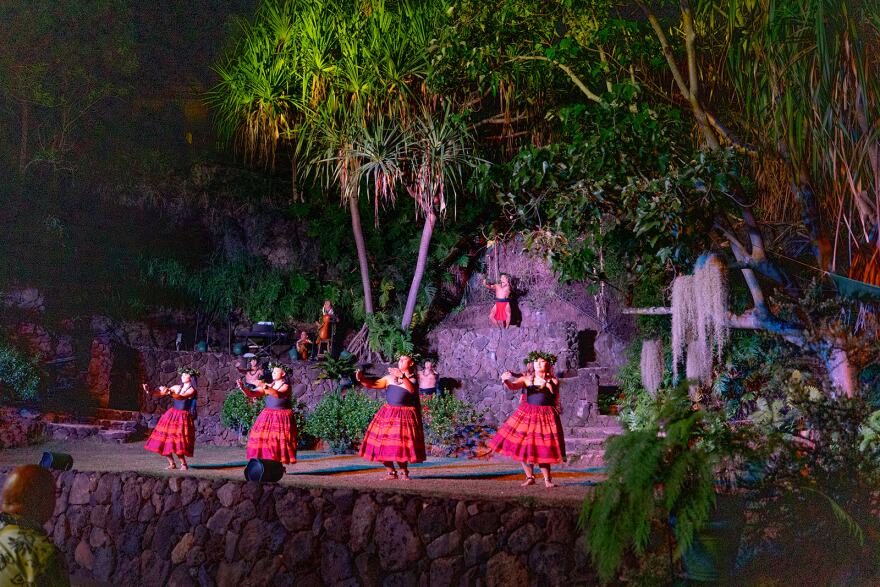On a recent Friday evening, hula dancers gracefully took the stage performing a series of chants at the Queen's Aloha Lūʻau. But it's not like the lūʻau seen throughout Waikīkī. Instead, it's in the backyard of a cultural practitioner's home in Punchbowl.
Eyes were drawn to the performers as Kumu Hula Karl Veto Baker led the show. He struck the gourd drum, singing harmoniously about Hawaiʻi's history, the late Queen Liliʻuokalani, and Pele, the goddess of volcanoes.
"When we hit the ipu, the gourd, it's not just to make sounds because it's exciting to hear the sounds," he said. "When we hit that ipu, it's because we're going to tell a story."

For the past few decades, Native Hawaiian culture has taken a back seat to most performances catered to tourists. Now, some Native Hawaiian-led organizations and cultural practitioners are putting the spotlight back on the host culture of Hawaiʻi.
Launched in 2022, the idea of the Queen's Aloha Lūʻau came from what Baker said is a lack of Native Hawaiian culture in contemporary lūʻau, which incorporated Tahitian dancing, Maori poi spinning, fire dancing and other Polynesian dances.
"If you had that historical, cultural background in our Hawaiian culture, you would be able to design a show in Hawaiian, not just Polynesian, that will touch people," he said. "We want to allow people to come to the shows and see why we're saying this, and they can come and feel the difference."
Reclaiming space
But this all-Hawaiian show is a tribute to Queen Liliʻuokalani, whose portrait hangs on the walls of Baker's halau. He teared up as he explained to a room of more than a dozen visitors and locals about the 1893 overthrow of the Hawaiian Kingdom.
Baker's home, Keonaonalani, is named after his great-grandmother, a lady in waiting for the last reigning monarch.

The Queen's Aloha Lūʻau sets visitors up for a feast and the show. Since the show is dedicated to Hawaiian culture, Baker said he and Kumu Hula Michael Lanakila Casupang have written original songs woven into the show.
"When Lanakila and I sing, the song might be to bring our queen alive," Baker said. "They may be songs written for her, by her. And when people hear those songs, they have an appreciation of why we love our Queen Liliʻuokalani."
In recent years, there's been a push for more all-Hawaiian shows to help educate visitors on Hawaiian history through storytelling, dance and song.
Also launched this year was the Kilohana Hula Show, a remake of the iconic Kodak Hula Show that was discontinued in 2002 after 65 years of performances.
Māhealani Kamau has been dancing hula for more than 30 years. She recently performed at the Kilohana Hula Show and taught a group of visitors how to dance hula.
She said Hawaiian music and hula were more prevalent in Waikīkī, but as she started performing professionally, she noticed the commercialization of hula was being made "flashy" to visitors but also hypersexualizing Indigenous women.
"I lived off island for a really long time and people started to relate to Hawaiʻi as coconut bras, drums, the fire knife dance (and) Tahitian dancing," said Kamau, who lived and danced in Florida for 17 years. "People thought it was Hawaiian, and I was noticing that shift and that we weren't getting that representation that is truly Hawaiian."
Kamau said it's been a challenge "to reclaim our space" in the tourism industry.
When she moved back to Hawaiʻi from Florida about six months ago, Kamau said she told herself that she would never dance again.
"I very much wanted to contribute to Hawaiʻi and not promote the sexualization of hula and Hawaiʻi," she said, adding that she went back into dancing after learning about the opening of the Kilohana Hula Show.

The Kilohana Hula Show is a partnership between the Council for Native Hawaiian Advancement and the City and County of Honolulu.
Kamau said it was an honor to perform in the show while portraying authentic Hawaiian representation.
"As hula dancers, we are truly the historians and the keepers of our people's histories," she said.
"It's been there all along"
But the question has less to do with which Polynesian culture is represented, according to Ty Kawika Tengan, an ethnic studies professor at the University of Hawaiʻi.
"To what extent do in the case of Native Hawaiian participating in the field are they able to control the narrative to materially benefit but also see those benefits feed into the support of our broader community and the land themselves?" he said.
He added that there shouldn't be a separation between performances and environmental impacts of the tourism industry.

Kalani Kaʻanāʻanā is the chief brand officer at the Hawaiʻi Tourism Authority. He said that there's always room for improvement but stressed that Hawaiian culture has always been in Waikīkī.
"It's been there all along, and maybe it hasn't necessarily been in the spotlight or taken from or center stage as it were," he said.
He said it's important to understand the evolution of Hawaiian culture throughout the history of tourism, from the hypersexualization of Hawaiian women and the tiki kitsch culture to the Hawaiian Renaissance bringing awareness to the culture.
"Looking back, some of that would never fly today, for sure," he said. "But it comes from a place of curiosity and learning that has really helped us to develop and evolve what it is and how we portray it."
Karl Veto Baker hopes more cultural practitioners will have a seat at the table to discuss more Hawaiian-led shows.
"Maybe more of the practitioners now can come and set up their small little lūʻau so that we have more of these for people to come," he said. "If I do 100 people a night or that's 300 people a week, that's only a drop in a bucket of the 10 million that come here."





